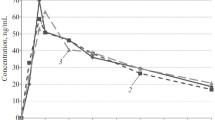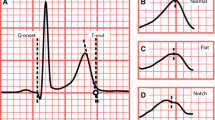Summary
A placebo-controlled, single blind, cross-over study was done to evaluate the inotropic effects of single oral doses of mexiletine and disopyramide assessed by the measurement of Systolic Time Intervals (STI). Each of 8 healthy volunteers received five treatments in random order: 200 and 400 mg mexiletine, 100 and 200 mg disopyramide, and placebo. There was a significant increase in cumulated PEP after 400 mg mexiletine and 200 mg disopyramide. There was no significant change in LVET and QS2. Peak plasma levels were in the lower range of the reputed antiarrythmic levels. Plasma concentration-effect relationships are discussed. Although the study revealed large inter- and intrasubject variability in the measured STIs, it is concluded that a negative inotropic effect was detected despite the low plasma levels of the minor negative inotropic drugs.
Similar content being viewed by others
References
Andarelli MA, Farinotti R, Dauphin A (1982) Dosage plasmatique de la mexilétine par chromatographie en phase liquide après dérivatisation par la fluorescamine. J Pharm Clin 1: 113–122
Böcker K, Köhler E, Seipel L, Loogen F (1982) Die Wirkung von Disopyramid, Mexiletin und Propafenon nach intravenöser und oraler Gabe auf die Funktion des linken Ventrikels in M-Mode-Echokardiogramm. Z Kardiol 71: 839–845
Boudoulas H, Schaa SF, Lewis RP, Welch TG, Degreen P, Kates RE (1977) Negative inotropic effect of lidocaine in patients with coronary arterial disease and normal subjects. Chest 71: 170–174
Campbell NPS, Zaïdi SA, Adgey AA (1979) Observations on haemodynamic effects of mexiletine. Br Heart J 12: 182–186
Chew CYC, Collett J, Singh BN (1979) Mexiletine: A review of its pharmacological properties and therapeutic efficacy in arrhythmias. Drugs 17: 161–181
Cousineau D, Lapointe L, de Champlain J (1978) Circulating coathecholamine and systolic time intervals in normotensive and hypertensive patients with and without left ventricular hypertrophy. Am Heart J 96: 227–234
Dove P, Leclerc JF, Blondeau M (1982) Effets secondaires, toxicité et accidents des médicaments antiarythmiques. Thérapie 37: 299–314
Giacomini KM, Blaschke TF (1984) Effect of concentration dependent binding to plasma proteine on the pharmacokinetics and pharmacodynamics of disopyramide. Clin Pharmacokinet 9 [Suppl 1]: 42–48
Gibassier D, Sado P, Devissaguet JP, Leverge R (1982) Suivi thérapeutique d'un antiarythmique à fixation protéique non linéaire. J Pharm Clin 1: 89–104
Gibson DG (1980) Use of the systolic time intervals in clinical pharmacology. In: Shanks RG (ed) Cardio-vascular system. 1. Methods in clinical pharmacology. pp 14–19 (Br J Clin Pharmacol 7: 443–449 (1979))
Hoeschen RJ, Coddy TE (1975) Dose response relation between therapeutic levels of serum digoxin and systolic time intervals. Am J Cardiol 35: 469–471
Ishikawa K, Ishikawa M, Morihara H, Yanagisawa A, Muramatsu J, Sawayama T, Maeda K (1982) Intra- and interobserver variations in the measurement of systolic time intervals. Chest 81: 341–345
Johnson BF, Meeran MK, Frank A, Taylor SH (1981) Systolic time intervals in measurement of inotropic response to drugs. Br Heart J 46: 513–521
Kelman AW, Sumner DJ, Whiting B (1981) Systolic time intervals versus heart rate regression equations using atropine: reproductibility studies. Br J Clin Pharmacol 12: 15–20
Kyle MC, Freis ED (1980) Serial measurements of systolic time intervals: Effects of popranolol alone and combined with other agents in hypertensive patients. Hypertension 2: 111–117
Leach A, Brown J, Armstrong P (1980) Cardiac depression by intravenous disopyramide in patients with left ventricular dysfunction. Am J Med 68: 839
Lewis RP, Rittgers SE, Forester WF, Boudoulas H (1977) A critical review of the systolic time intervals. Circulation 56: 146–158
Lima JL, Boudoulas H, Canford M (1981) Concentration dependence of disopyramide binding to plasma protein and its influence on kinetics and dynamics. J Pharmacol Exp Ther 219: 741–747
Pottage A (1977) Oral dosages schedules for mexiletine. Postgrad Med J 53 [Suppl 1]: 155–157
Spodick DH (1978) Heart rate correction of preejection period. Am Heart J 96: 705
Spodick DH, Doi YL, Bishop RL, Hashimoto T (1984) Systolic time intervals reconsidered. Reevaluation of the preejection period: Absence of relation to heart rate. Am J Cardiol 53: 1667–1670
Vaughan Williams EM (1984) A classification of antiarrhythmic actions reassessed after a decade of new drugs. J Clin Pharmacol 24: 129–147
Walsh RA, Crawford MH, O'Rourke RA (1982) Relative sensitivity of echocardiography and systolic time intervals for assessing acute positive inotropic interventions in normal human subjects. Am Heart J 104: 1061–1070
Wanderman KL, Loutaty G, Ousyscher J, Cantor A, Gussarsky Y, Gueron M (1981) Choice of electrocardiographic leads for recording the earliest QRS onset in noninvasive measurements. Circulation 63: 933
Weissler AM, Harris WS, Schoenfeld CD (1968) Systolic time intervals in heart failure in man. Circulation 37: 149–159
Whiting B, Holford NHG, Steiner LB (1980) Quantitative analysis of the disopyramide: Concentration-effect relationship. Br J Clin Pharmacol 9: 67–75
Whiting B, Kelman AW, Sumner DJ, Hillis WS, Ledermann H (1982) Haemodynamic effects of BM 10.188, a new orally active inotropic agent, in healthy volunteers. Br J Clin Pharmacol 13: 529–532
Author information
Authors and Affiliations
Rights and permissions
About this article
Cite this article
Rousson, D., Piolat, C., Galleyrand, J. et al. Systolic time intervals in evaluation of the negative inotropic effect after single oral doses of mexiletine and disopyramide. Eur J Clin Pharmacol 30, 263–268 (1986). https://doi.org/10.1007/BF00541525
Received:
Accepted:
Issue Date:
DOI: https://doi.org/10.1007/BF00541525




